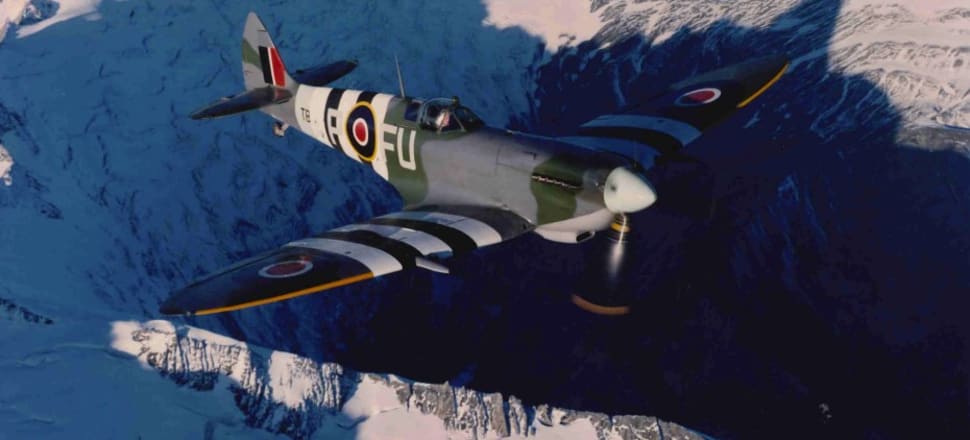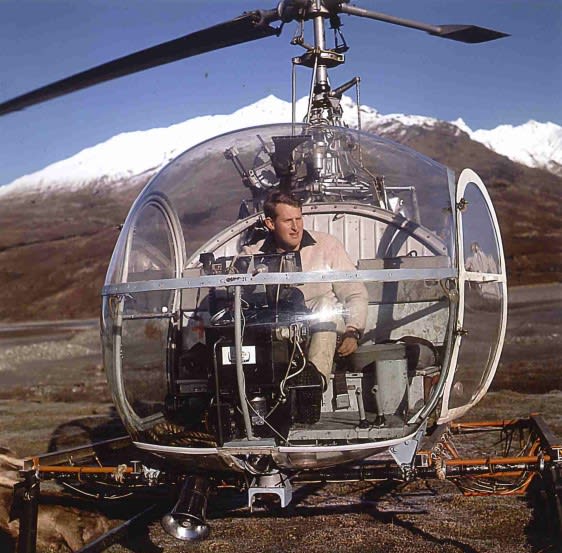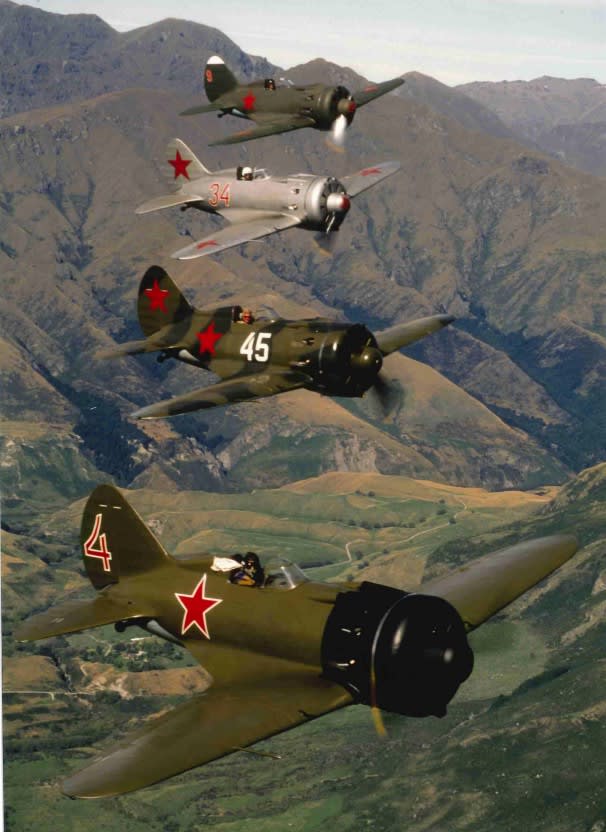
A love of aircraft, adventure and honouring the NZ pilots and ground crew from World War 2 marked the great life of Sir Tim Wallis, writes former colleague Ian Brodie
During WWII a squat Russian fighter played an integral role in the conflict between Russia and Nazi Germany. Fifty seven years later, that aircraft and more than 75,000 New Zealanders would be inexorably linked at the 1998 Warbirds Over Wanaka, held at the small town of Wanaka in Central Otago.
To find the beginnings of that link we must travel back to Christchurch in 1938, when Timothy William Wallis was born. Brought up in Greymouth on the West Coast, Tim eventually returned to Christchurch to attend Christ’s College. Bitten by the aviation bug, Tim would frequently cycle to the RNZAF base at Wigram to view practising aircraft. The sight and sound of the North American P-51D Mustang caught his attention, in particular that of Squadron Leader Ray Archibald, with its non-standard red spinner.
When he left school to work at his father’s timber mill at Haupiri on the West Coast, Tim's love of aircraft was temporarily put on the back burner.
In the early 1980s Tim was at a point in his life where he could afford to revisit his schoolboy aviation memories. He contacted Ray Mulqueen, an aircraft engineer, to travel overseas in search of a suitable North American P-51D for purchase. They opted for a rebuild, which was completed in 1984. The aircraft was painted in the colour scheme of the 3rd Squadron of the Territorial Airforce which had been based in Christchurch during the 1950s. The spinner was painted bright red.
A sight not seen in New Zealand for over 20 years delighted airshow crowds over the next few years. The Mustang continued to give Tim immense enjoyment, however, the idea of a Spitfire became prominent in his mind, chiefly because he would be able to fly the machine.
More than anything else Tim enjoyed sharing his warbird interest with others and in mid-1987 he decided to hold an airshow. He called on the Wanaka Lions Club and asked for their assistance with the organisation of a show to be held in January 1988. Locals thought it a good idea but didn’t consider January a good time for an airshow – Wanaka would already be inundated with holidaymakers. The asked him to consider the Easter break with an eye to broadening their window of opportunity for attracting people to the area.

Warbirds on Parade 1988 was an astounding success, with more than 14,000 people visiting the small Wanaka Airfield to enjoy a day of flying. The dinner and the party on the Saturday night, held to honour the organisers of the show, was almost as memorable. The airfield runway had only been sealed the year before and it seemed an unlikely place to hold an airshow, but to Tim it was very logical – aeroplanes and mountains being his great loves, at Wanaka they could be seen together.
Buoyed by the show's success, the organisers decided to plan biennial airshows, to be held at Easter. The show was renamed Warbirds Over Wanaka.
In 1989, a Supermarine MkXVI Spitfire was purchased from England. TB863 very quickly became a Kiwi icon and its purchase was largely responsible for the strong warbird movement in New Zealand today.
Following the 1988 airshow Tim visited Russia. However his visit was not only in relation to his deer interests. The warbird movement was abuzz with stories of crashed aircraft littering the Russian tundra just waiting to be collected. Tim set out to find them. Hiring a Mil-8 helicopter he became one of the first westerners to visit the Kurill Islands (north of Japan). Here he saw many wrecks and took video of the aircraft as well as filming the abandoned Japanese hangars and bunkers. Despite this veritable treasure trove he quickly discovered that while the aircraft were there it would not easy to obtain them. He returned to Wanaka with many ideas but no definite plans.
Easter 1990 arrived and 28,000 people arrived at Warbirds Over Wanaka to share Tim's passion. News of the success of the 1988 event had spread and 1990 saw number of overseas visitors attend, including Pilot Officer Rusty Leith from Australia. Rusty, a wartime Spitfire pilot with 453 Squadron RAAF was very keen to see Tim’s Spitfire in flight as it was the same aircraft he had flown in combat over Europe 45 years previously.
Tim's interest in warbirds always extended to those people who flew and serviced these aircraft during conflict, and he made a particular point of tracking Rusty down in Perth, Western Australia and hosting him as a guest of honour at the event.
Tim returned to Russia in 1991 and inspected the many wrecks which littered the tundra in the Murmansk area – Me-109’s and 110’s Focke Wulf 190’s, Yak-3’s – all were there but lack of reliable engine sources prevented restoration. As he conversed with Russian WWII fighter pilots and engineers, the aircraft designed by Nikolai Polikarpov during the 1930s began to capture his imagination. While the west was still experimenting with the monoplane, the Polikarpov Design Bureau had produced the first low-wing cantilever monoplane with a retractable undercarriage. This feat is one the majority of the western world is unaware of, and the Polikarpov aircraft represent great strides in aviation engineering for that time.
Realising the historical significance of the I-16 – it was the most abundant fighter when Germany invaded Russia in 1941 – Tim proceeded to dust off aircraft plans which had been discovered in a Novosibirsk aircraft factory. Additionally, he learnt that the original M-61 engine of the I-16 was identical to that used in the Antonov AN-2, a passenger aircraft still in operation. Consequently, the Polikarpov I-153 also captured Tim's imagination; it too was powered by the M-62 engine. At this time there were no flying examples of either type in the world and only a handful were in existence – all silent in museums.

Tim’s “good idea” was given motion but it was an idea that was to try him and his team to sheer distraction. Enough Polikarpov wrecks had been found to settle on rebuilding six I-16’s and three I-153’s to flying standard.
It was Tim’s, single-mindedness and perseverance that brought his wish to own the I-16 and the I-153 to fruition over the next six years.
Tim continued the expansion of his Wanaka-based Alpine Fighter Collection and worked hard to make the 1992 show a special one. Many New Zealand enthusiasts labelled 1992 as the “year of the 109”. Tim wanted the show to grow and he knew they would always need new and different displays. A decision was made to bring a Messerschmitt Me-109J (Buchon) from England for the show. It was this one aircraft and its advertised dogfight with the Alpine Spitfire that captured public imagination before the show and ensured an attendance of over 55,000. Tim also had a Corsair and a Kittyhawk to share with his friends.
That passion for warbirds had always incorporated those young Kiwis who had flown in the World Wars in remarkable numbers and in 1992 he announced the development of the NZ Fighter Pilots Museum at Wanaka Airport. A place where visitors could see the Alpine Fighter Collection year-round – and learn about the pilots who flew them and groundcrew who serviced them.
Over Easter 1993 the museum opened, and a number of invited fighter pilots were celebrated with a party that brought many of them together for the first time in decades. They were wined, dined and honoured as a group, enjoying a bonhomie that many had not experienced for years. Tim loved it – he flew the Spitfire for them, he hosted a barbecue for them up the Matukutuki Valley and then flew them all on a sightseeing trip around his beloved Mt Aspiring in HOT (his Hughes 369D helicopter).
In 1995, Tim took over RNZAF Base Wigram for a party to honour the 50th Anniversary of the ending of WWII. This “party” turned into a celebration that saw a spectacular airshow and another legendary welcome to all servicemen and women (they were given free entry) and hosted in a hospitality tent. It took 50 years off their lives.
In January 1996 Tim flew his Spitfire for the last time. Down but never out – he continued to share his enthusiasm and passion through the NZ Fighter Pilots Museum and the Alpine Fighter Collection.
During Labour Weekend 1997 the New Zealand Fighter Pilots Museum played host to one of the largest reunions of fighter pilots held for years. Although much of the talk centred on happenings of over 50 years ago, the pilots were treated to an event they would never forget – the full-on test flying programme of four Polikarpov I-16s. It was the first time one of these aircraft had ever flown in the southern hemisphere. Tim’s single-mindedness had resulted in a significant international aviation event.
On April 10,1998 Warbirds Over Wanaka opened its gates and more than 75,000 people witnessed five Polikarpov I-16s swooping and diving over the magnificent Wanaka scenery. For a brief moment in time, Wanaka and a war fought so many years ago over a distant continent were linked. Those small stubby fighters from another time left the whole crowd spellbound; on top of the commentary bus I watched Sir Tim Wallis and his Russian guests’ smiles turn to laughter and tears.
But Tim still had other aircraft being restored and this led to one of the most magical moments ever seen at an airshow – and still talked about today. In 2000, more than 100,000 people witnessed a flypast not seen anywhere since 1945 when five I-16’s, three I-153 and a Hawker Hurricane (rebuilt by Air NZ in Christchurch) flew centre stage.
Over the next 10 years, Warbirds Over Wanaka continued to grow and expand with that enthusiasm and flair of Tim always in the mind of the organising team, and this led to many special happenings – both airborne and iconic. In 1996 Chuck Yeager (fighter pilot and first person to break the speed of sound) attended the show and then in 2004 Dr. ‘Buzz’ Aldrin (second man to walk on the moon) stood on the commentary bus and regaled the crowd of more than 100,000 with his exploits.
The Alpine Fighter Collection was part of Tim’s soul but after his 1996 accident it was inevitable that this collection would diminish – he couldn’t fly any more and the operation and restoration of warbirds was a financial drain.
During 2011 the Alpine Fighter Collection was wound up and the NZ Fighter Pilots Museum closed. It was the end of an era – and signalled a shifting of the warbird scene to other parts of the country.
This very brief history is just part of the life of Sir Tim Wallis and it is appropriate now to reflect upon the profound concept of legacy. Tim had an immeasurable impact on the lives of all he encountered - his passion and enthusiasm was infectious and his willingness to share that love of warbirds and those that flew them was unprecedented in our country.
He brought a deserved honour to all those pilots and ground crew, bringing a feeling of togetherness for those that flew with the RAF or RNZAF. His audacity at finding and collecting warbirds has also left us a legacy worldwide. That Spitfire and Me-109 in Seattle, a Me-110 in Berlin, another Spitfire in Australia, a Corsair in Brazil, a Hurricane in England, a Chipmunk in Masterton are all with us because of one man – Tim Wallis.
Tim, those 20 years in Wanaka were the highlight of my life. Thank you.
* Sir Tim Wallis died on Tuesday in Wanaka, aged 85







